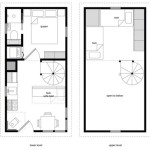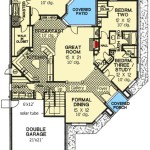A house extension is an addition to an existing structure to increase its square footage and functionality. Usually, a house extension is planned to create additional bedrooms, bathrooms, or living space.
House extension plans are technical drawings that outline the design, materials, and construction methods for an extension. These plans are typically prepared by an architect or draftsperson and must comply with local building codes.
In the following sections, we will explore the different types of house extension plans, the factors to consider when designing an extension, and the steps involved in the planning and construction process. We will also provide tips on how to get the most out of your house extension and avoid common pitfalls.
Here are 10 important points about house extension plans:
- Define the scope of the project
- Hire a qualified architect or draftsperson
- Obtain planning permission
- Choose the right materials
- Consider the impact on the existing structure
- Plan for adequate ventilation and natural light
- Create a realistic budget
- Get multiple quotes from contractors
- Supervise the construction process
- Enjoy your new space!
By following these tips, you can ensure that your house extension is a success.
Define the scope of the project
The first step in planning a house extension is to define the scope of the project. This involves determining the following:
- The purpose of the extension: What do you need the additional space for? Will it be used for a new bedroom, bathroom, living room, or home office?
- The size of the extension: How much additional space do you need? This will determine the size and scale of the extension.
- The location of the extension: Where on your property will the extension be built? Consider factors such as sunlight, privacy, and access to the existing house.
- The budget for the extension: How much can you afford to spend on the project? This will help you determine the materials and finishes you can use.
Once you have defined the scope of the project, you can start to develop a design brief. This document will outline your requirements for the extension, including the desired style, materials, and features. The design brief will be used by your architect or draftsperson to create house extension plans.
It is important to define the scope of the project as clearly as possible. This will help to avoid misunderstandings and delays during the planning and construction process.
Here are some additional tips for defining the scope of your house extension project:
- Start by creating a wish list of everything you would like to include in your extension. This will help you to prioritize your needs and determine what is essential and what is optional.
- Talk to your family and household members about their needs and wants for the extension. This will help you to create a design that meets the needs of everyone who will be using the space.
- Consider your lifestyle and how you use your home. This will help you to design an extension that is functional and meets your specific needs.
- Do your research and look at examples of other house extensions. This will help you to get ideas and inspiration for your own project.
- Once you have a good understanding of your needs and wants, you can start to develop a budget for the project. This will help you to determine what is feasible and what is not.
Hire a qualified architect or draftsperson
Once you have defined the scope of your house extension project, the next step is to hire a qualified architect or draftsperson. An architect or draftsperson will be able to help you to design your extension and prepare the necessary house extension plans.
When choosing an architect or draftsperson, it is important to consider their experience and qualifications. You should also ask for references from previous clients. It is also important to make sure that the architect or draftsperson is familiar with the local building codes and regulations.
A qualified architect or draftsperson will be able to help you to create a design that meets your needs and budget. They will also be able to prepare the necessary house extension plans, which will be required for planning permission and building regulations approval.
The role of an architect or draftsperson in a house extension project typically includes the following:
- Preparing a design brief based on your requirements
- Creating house extension plans
- Submitting plans for planning permission and building regulations approval
- Working with contractors to ensure that the extension is built to the correct specifications
- Providing ongoing support and advice throughout the project
Hiring a qualified architect or draftsperson is an important step in any house extension project. A good architect or draftsperson will be able to help you to create a design that meets your needs and budget, and they will also be able to ensure that the extension is built to the correct standards.
Obtain planning permission
Before you can start building your house extension, you will need to obtain planning permission from your local authority. Planning permission is a legal requirement that ensures that your extension complies with local building regulations and planning policies.
To apply for planning permission, you will need to submit a planning application to your local authority. The planning application will include the following:
- A completed planning application form
- House extension plans
- A site plan
- A design and access statement
- Any other supporting documents that may be required
Once you have submitted your planning application, it will be assessed by a planning officer. The planning officer will consider the following factors when making their decision:
- The design of the extension
- The impact of the extension on the surrounding area
- The local planning policies
If the planning officer approves your application, you will be granted planning permission. You will then be able to start building your extension.
It is important to note that planning permission can take several weeks or even months to be granted. It is therefore important to start the planning process as early as possible.
Here are some additional tips for obtaining planning permission for your house extension:
- Make sure that your house extension plans are drawn up by a qualified architect or draftsperson.
- Submit your planning application well in advance of when you want to start building.
- Be prepared to answer any questions that the planning officer may have about your application.
- If your application is refused, you can appeal the decision to the Planning Inspectorate.
Choose the right materials
The choice of materials for your house extension is an important one. The materials you choose will affect the appearance, durability, and cost of your extension.
Here are some factors to consider when choosing materials for your house extension:
- The style of your house: The materials you choose for your extension should complement the style of your house. For example, if your house is made of brick, you may want to use brick or stone for your extension.
- The climate in your area: The climate in your area will affect the durability of the materials you choose. For example, if you live in an area with extreme weather conditions, you may want to choose materials that are resistant to wind, rain, and snow.
- Your budget: The cost of materials will vary depending on the type of material you choose. You should set a budget for your extension before you start choosing materials.
Here is a list of some of the most common materials used for house extensions:
- Brick: Brick is a durable and attractive material that is available in a variety of colors and styles. Brick is also relatively easy to maintain.
- Stone: Stone is another durable and attractive material that can be used for house extensions. Stone is more expensive than brick, but it can add a touch of luxury to your home.
- Timber: Timber is a versatile material that can be used for a variety of purposes in house extensions. Timber is relatively inexpensive, but it requires more maintenance than brick or stone.
- Render: Render is a type of plaster that is applied to the exterior walls of a house. Render is a relatively inexpensive material that can be used to create a variety of finishes.
Once you have considered all of the factors above, you can start to choose the materials for your house extension. It is important to do your research and compare the different materials before making a decision.
Consider the impact on the existing structure
When planning a house extension, it is important to consider the impact that the extension will have on the existing structure. This includes the following:
- The weight of the extension: The weight of the extension will need to be supported by the existing structure. If the existing structure is not strong enough to support the weight of the extension, it will need to be reinforced.
- The location of the extension: The location of the extension will affect the way that it is connected to the existing structure. For example, an extension that is built on the side of the house will have a different impact on the structure than an extension that is built on the back of the house.
- The type of extension: The type of extension will also affect the impact that it has on the existing structure. For example, a single-story extension will have a different impact on the structure than a two-story extension.
It is important to consult with a structural engineer to assess the impact that the extension will have on the existing structure. The structural engineer will be able to recommend any necessary reinforcements or modifications to the existing structure.
Here are some additional tips for considering the impact of your house extension on the existing structure:
- Hire a qualified architect or draftsperson: A qualified architect or draftsperson will be able to design an extension that is compatible with the existing structure.
- Get a structural engineer to assess the impact of the extension: A structural engineer will be able to recommend any necessary reinforcements or modifications to the existing structure.
- Use lightweight materials: Lightweight materials can help to reduce the weight of the extension and minimize the impact on the existing structure.
- Consider the location of the extension: The location of the extension will affect the way that it is connected to the existing structure. Choose a location that will minimize the impact on the structure.
By following these tips, you can help to ensure that your house extension is safe and structurally sound.
Plan for adequate ventilation and natural light
Adequate ventilation is essential for a healthy and comfortable home. It helps to remove stale air and moisture, and it can also help to reduce the risk of condensation and mould growth. When planning your house extension, it is important to consider how you will provide adequate ventilation for the new space.
There are a number of ways to provide ventilation in a house extension. One option is to install windows and doors that can be opened to allow fresh air to circulate. Another option is to install mechanical ventilation systems, such as fans or air conditioning units. If you are planning to install a new kitchen or bathroom in your extension, you will need to ensure that these rooms are properly ventilated to remove cooking fumes and moisture.
Natural light is also important for a healthy and comfortable home. It can help to improve your mood and energy levels, and it can also help to reduce the risk of eye strain. When planning your house extension, it is important to consider how you will maximize the amount of natural light in the new space.
There are a number of ways to maximize natural light in a house extension. One option is to install large windows and doors that allow plenty of light to enter. Another option is to use skylights or rooflights to bring light into the space from above. If you are planning to install a new kitchen or bathroom in your extension, you should consider placing these rooms in a part of the house that receives plenty of natural light.
By following these tips, you can help to ensure that your house extension is well-ventilated and has plenty of natural light. This will create a healthy and comfortable space for you and your family to enjoy.
Create a realistic budget
One of the most important aspects of planning a house extension is creating a realistic budget. This will help you to avoid overspending and ensure that your project is completed on time and within your financial means.
- Estimate the cost of materials: The cost of materials will vary depending on the type of materials you choose and the size of your extension. It is important to get quotes from several suppliers before making a decision.
- Factor in labor costs: The cost of labor will also vary depending on the size and complexity of your project. It is important to get quotes from several contractors before hiring one.
- Allow for unexpected costs: There are always unexpected costs that can arise during a house extension project. It is important to set aside a contingency fund to cover these costs.
- Consider the long-term costs: In addition to the upfront costs of the extension, you will also need to consider the long-term costs of maintaining and heating the new space.
Once you have estimated the cost of your extension, you can start to create a budget. It is important to be realistic about your budget and to make sure that you can afford the project before you start. If you are not sure how much you can afford to spend, you should speak to a financial advisor.
Get multiple quotes from contractors
Once you have created a budget for your house extension, you can start to get quotes from contractors. It is important to get quotes from several contractors before hiring one. This will help you to ensure that you are getting the best possible price for your project.
- Ask for detailed quotes: When you are getting quotes from contractors, be sure to ask for detailed quotes that include the cost of materials, labor, and any other associated costs. This will help you to compare the quotes more easily and make an informed decision.
- Compare the quotes carefully: Once you have received quotes from several contractors, take the time to compare them carefully. Be sure to compare the cost of materials, labor, and any other associated costs. You should also compare the experience and qualifications of the contractors.
- Check references: Before hiring a contractor, be sure to check their references. This will help you to ensure that they are a reputable company with a good track record.
- Get everything in writing: Once you have chosen a contractor, be sure to get everything in writing. This includes the cost of the project, the timeline for completion, and any other important details.
By following these tips, you can help to ensure that you get the best possible price for your house extension and that the project is completed on time and within your budget.
Supervise the construction process
Once you have hired a contractor and obtained the necessary permits, the construction process can begin. It is important to supervise the construction process to ensure that the project is completed on time, within budget, and to your satisfaction.
Here are some tips for supervising the construction process:
- Visit the site regularly: It is important to visit the construction site regularly to monitor the progress of the project and to identify any potential problems early on.
- Inspect the work: When you visit the site, take the time to inspect the work that has been completed. Make sure that the work is being done to your satisfaction and in accordance with the plans and specifications.
- Communicate with the contractor: It is important to communicate with the contractor regularly to discuss the progress of the project and to address any concerns that you may have.
- Keep records: It is important to keep records of all communications with the contractor, as well as any changes that are made to the plans or specifications.
By following these tips, you can help to ensure that your house extension is completed on time, within budget, and to your satisfaction.
Enjoy your new space!
Once your house extension is complete, it is time to enjoy your new space! There are many ways to make the most of your new addition, such as:
- Creating a new living area: Your new extension can be used to create a new living area, such as a family room, playroom, or home office.
- Expanding an existing room: Your new extension can be used to expand an existing room, such as the kitchen, dining room, or master bedroom.
- Adding a new bathroom: Your new extension can be used to add a new bathroom, which can be especially useful if your family is growing.
- Creating a home gym: Your new extension can be used to create a home gym, which is a great way to stay fit and healthy.
No matter how you choose to use your new space, it is sure to add value and enjoyment to your home. Here are a few tips for making the most of your new extension:
- Decorate to your taste: Decorate your new extension to your own taste and style. This will help to make it feel like a truly personal space.
- Use the space for activities you enjoy: Use your new extension for activities that you enjoy, such as spending time with family and friends, reading, or watching movies.
- Keep the space clean and tidy: Keep your new extension clean and tidy to help it maintain its value and appeal.
Make the most of your natural light
If your new extension has windows or skylights, make the most of the natural light. Natural light can help to improve your mood and energy levels, and it can also help to reduce the risk of eye strain. Here are a few tips for making the most of your natural light:
- Keep windows and skylights clean: Keep your windows and skylights clean to allow as much natural light as possible to enter your home.
- Use sheer curtains or blinds: Use sheer curtains or blinds to allow natural light to enter your home while still providing privacy.
- Place furniture near windows: Place furniture near windows to take advantage of the natural light.
Choose the right furniture and accessories
The furniture and accessories you choose for your new extension will have a big impact on the overall look and feel of the space. Here are a few tips for choosing the right furniture and accessories:
- Choose furniture that is the right size and scale for the space: Choose furniture that is the right size and scale for the space. Oversized furniture can make a small space feel even smaller, while undersized furniture can make a large space feel empty.
- Choose furniture that is comfortable and stylish: Choose furniture that is comfortable and stylish. You want to create a space that is both inviting and functional.
- Add personal touches: Add personal touches to your new extension to make it feel like a truly unique space.
Enjoy your new space!
Your new house extension is a great place to relax, entertain guests, and create lasting memories. Enjoy your new space!










Related Posts








